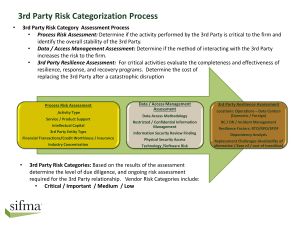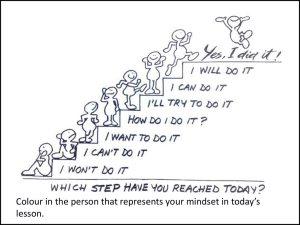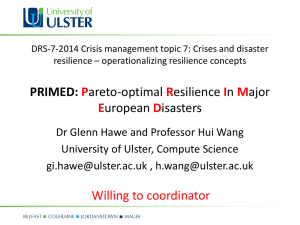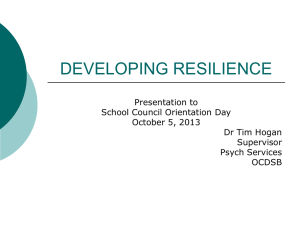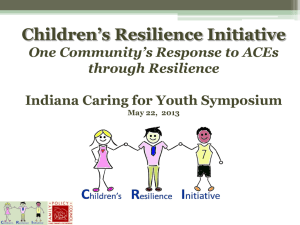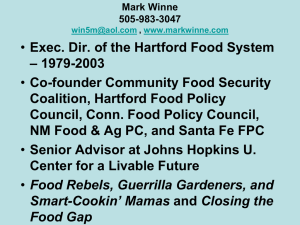Positive Adaptation - Resilience Trumps ACEs
advertisement
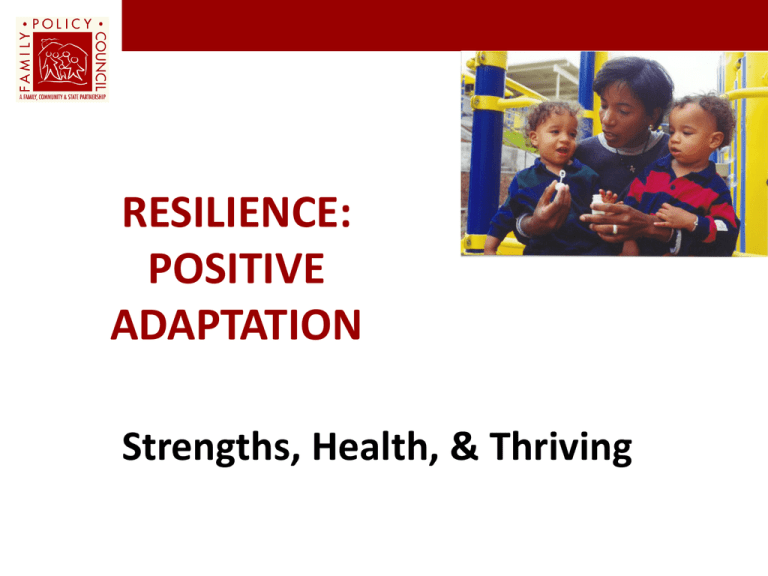
RESILIENCE: POSITIVE ADAPTATION Strengths, Health, & Thriving FACTORS THAT INFLUENCE HEALTH Health Care 10% Environment 22% Genetics 17% How We Live 51% Source: USDHEW, PHS, CDC. “Ten Leading Causes of Death in US 1975, Georgia Bureau of State Services, Health Analysis and Planning for Preventive Services, p. 35, 1978 ACE REDUCTION: A POWERFUL FRAMEWORK FOR THRIVING A: Improve General Community Capacity to Come Together, Identify and Address Issues that Matter Most. B: Reduce Median Adverse Childhood Experiences (ACEs) Scores from One Generation to the Next. C: Improve Societal Expectations and Response to High ACE People to Reduce Secondary Trauma, Reduce Burden of Chronic Disease and Optimize Wellbeing Through The Lifespan. Physiologic Adaptation; Hard-wired Rapid Stress Response Toxic Stress: Cumulative Stressors Over Time; Sensitive Developmental Periods Nutrition Genetic Predispositions Physical, Chemical, & Built Environment Relational Environment Foundations of Healthy Development and Sources of Adversity Skill-Building Stress: Short-Term Stressors in Supportive Environments; Protection in Sensitive Developmental Periods Epigenetics: Individual Experience Affects Gene Expression Societal Expectations and Response to Behavior Adapted to Relational, Benevolent World – Well Matched to Societal Expectations Developmental Determinants of Health Prosperity Health-Related Behavior Physical & Mental Health Life-Span Outcomes Adapted from Shonkoff, J.P., “Building a New Biodevelopmental Framework to Guide the Future of Early Childhood Policy,” Child Development, Jan./Feb. 2010. WHAT IS RESILIENCE? The natural human capacity to navigate life well. (HeavyRunner & Marshall, 2003) The capacity to absorb disturbance and reorganize while undergoing change, yet still retain essentially the same function, structure, identity, feedbacks. RESILIENCE OCCURS AT ALL LEVELS: (Walker et al., 2002) Individual The ability of an individual, system or organization to meet challenges, survive, and do well despite adversity. (Kirmayer, 2009) Family Community National, Global, Ecosystem PHASES IN RESILIENCE RESEARCH Descriptive – What do resilient individuals have in common? Predictive – How questions: identify and understand processes that might lead to resilience, including risk and protective factors. Contextual –Why ages, stages, personal and family history, community context matter for promotion of resilience. Integrative – Encompasses rapid advances in the study of genes, developmental neurobiology, neural plasticity, and the conditions, contexts, and processes that affect positive adaptation throughout the lifespan. “Resilience rests, fundamentally, on relationships”. Suniya Luthar; Resilience in development: A synthesis of research across five decades; 2006, p. 780 RESILIENCE AS A DEVELOPMENTAL PROCESS • We develop competencies & characteristics that prepare us to be effective in the world we’re growing into. • We develop the capacity to adapt in the face of challenges. • None of us is perfect—we’ll all have moments when we don’t appear to be very well adapted to the conditions we’re facing. • Resilience is complex; it is possible to be resilient in one setting and pathological in another. Interactions Among Biology, Psychology, Social Factors AgeAppropriate Social Behavior (Developmental Tasks) Developmental Framework for Resilience Multiple Contexts Age Related Patterns of Competence Interactions Among Biology, Psychology, Social Factors AgeAppropriate Social Behavior (Developmental Tasks) Age Related Patterns of Competence Developmental Framework for Resilience Multiple Contexts Growth Protection Nourishment Wholeness FINDING MEANING TEMPERING MASTERY HOPE RELATIONAL EXPERIENCE RECONSTRUC TING IDENTITY REVISING ATTACHMENT & BELONGING From: Loss, Trauma, and Resilience; Therapeutic Work with Ambiguous Loss; Dr. Pauline Boss; 2006 NORMALIZIN G AMBIVALENC E THREE CORE PROTECTIVE SYSTEMS 1. Community, Spiritual & Cultural Life 2. Attachment & Belonging 3. Capabilities “Nurturing the healthy development of these protective systems affords the most important preparation or ‘inoculation’ for overcoming potential threats and adversities in human development. Similarly, damage or destruction of these systems has dire consequences for the positive adaptive capacity of individuals.” Ann Masten, 2009 • Faith, hope, sense of meaning KEY SYSTEMS COMMUNITY, CULTURE, SPIRITUALITY FOR RESILIENCE Nourishment Protection Wholeness Growth CAPABILITY • Engagement with effective orgs – schools, work, pro-social groups • Network of supports/services & opportunity to help others • Cultures providing positive standards, expectations, rituals, relationships & supports ATTACHMENT & BELONGING • Bonds with parents and/or caregivers • Positive relationships with competent and nurturing adults • Friends or romantic partners who provide a sense of security & belonging • Intellectual & employable skills • Self regulation – self control, executive function, flexible thinking • Ability to direct & control attention, emotion, behavior • Positive self view, efficacy COMMUNITY, CULTURE, SPIRITUAL LIFE PRENATAL – INFANCY COMMUNITY, CULTURE, SPIRITUAL RITUALS & TRADITIONS IN CHILDHOOD MIDDLE CHILDHOOD PRE-TEEN & TEEN YEARS Spiritual engagement that demands active participation in a community of faith Structure, rules, & responsibility to contribute to family and community Parents/Family has: Spiritual engagement demands active participation in a community of faith Rituals & traditions supporting connection with the land (for some people) Value systems that include notions of personhood, ethics, religion or spirituality Cultural knowledge and practices supporting coherence and a source of stability & support PRE-CONCEPTION ADULT PROTECTIVE COMMUNITY, CULTURE, SPIRITUAL RITUALS & TRADITIONS PRE-SCHOOL PREGNANCY WITH YOUNG CHILDREN MOVING TOWARD MID-LIFE Spiritual engagement that demands active participation in a community of faith Rituals & traditions supporting connection with the land (for some people) Value systems that include notions of personhood, ethics, religion or spirituality Cultural knowledge and practices supporting coherence and a source of stability & support SUPPORTING ATTACHMENT & BELONGING PRENATAL – INFANCY PRE-SCHOOL MIDDLE CHILDHOOD PRE-TEEN & TEEN YEARS Four or fewer children; 2+ years between siblings ATTACHMENT & BELONGING IN CHILDHOOD Maternal competence: proportion of positive interactions with child Close bond with caregiver Parents have circle of people they can count on for help and support Caregiver sensitivity and responsiveness to infant needs No prolonged separation from parent in first year ADULT ATTACHMENT & BELONGING PRE-CONCEPTION PREGNANCY Number of stressful life events reported in childhood, adolescence Establish relationship with helper (doula, visitor, etc.) opens door to whole program of help, improves quality in relating with child Find ecological Niche for child – support in family, social network Emotional support from friends and family Sources of support that increase competencies, efficacy, opportunity to develop strengths, gifts and interests, and decrease stressful life WITH YOUNG CHILDREN MOVING TOWARD MID-LIFE Number of persons the individual turned to in times of crisis Help seeking; social network building (which also helps to mitigate the negative effects of poverty) Rewarded with repeated promotions contributes to sense of pride NURTURING CAPABILITY PRENATAL – INFANCY CAPABILITY IN CHILDHOOD MIDDLE CHILDHOOD PRE-TEEN & TEEN YEARS Developmentally appropriate physical activity Parental involvement in, promotion of, learning Good health & nutrition; Safety Ability to seek comfort, support or inspiration from others Stimulation – sound, sight, touch Scholastic competence Play, laughter, exploration Autonomy, social maturity, self efficacy, mastery motivation PRE-CONCEPTION PARENTAL CAPABILITY PRE-SCHOOL PREGNANCY WITH YOUNG CHILDREN MOVING TOWARD MID-LIFE Exercise, e.g. walking at 60% of vital capacity Identifying and using one’s core gifts Good health; Safety Ability to seek comfort, support or inspiration from others Resourceful and Imagine self as Continuing Opening of realistic in mother, dream education: academic opportunities educational and interaction with and vocational skills Successful adaptation vocational plans child; redefine acquired at midlife self Practice of seizing opportunities Growth RISK & PROTECTION INTERACT IN A CULTURAL CONTEXT Protection Nourishment Individuals Compensatory Protective Challenge Family & Community Cultural Wholeness Caring, Cohesion, Belief in Each Child Belonging with Peers, School, Circle of Success Non-punitive Provisions and Resources to Assist Belief in Societal Values Spirituality Traditional Activities Traditional Languages Traditional healing Elders Before WALLA WALLA COMMITMENT TO COMMUNITY Neighbors Unite To Build Community Park EXAMPLES OF PROGRAM & POLICY ACTIONS • Parent Trust for Washington Children has incorporated the ACE questions into their work with addicted parents facing court action (DV, termination of parental rights) resulting in: 1) improved outcomes in parenting classes and 2) reduced relapse among parents with 4 or more ACEs. • Safe Harbor Crisis Nursery in the Tri-Cities has incorporated ACEs and trauma into its day-to-day strategies and case management resulting in improved outcomes for families. • Children of Incarcerated Parents; the Legislature has mandated the executive branch to engage in an initiative to address the needs of children of incarcerated parents. The initiative and its processes are framed to address the likelihood that these children have more than this one ACE. • With the help of the Mental Health Transformation Grant and the Office of the Superintendent of Public Instruction (OSPI), Spokane is exploring the creation/implementation of trauma sensitive practices in public schools. • OSPI introduced the Compassionate Schools initiative, which supports local school districts in reducing the non-academic barriers to schools success that are created by trauma (2008). (http://www.k12.wa.us/CompassionateSchools/default.aspx) PORT GAMBLE S’KLALLAM TRIBE – CHI-E-CHEE (THE WORKERS) NETWORK ADVERSE CHILDHOOD EXPERIENCE We Can All Help 1. Build Capacity To Reduce Adverse Childhood Experience 2. Promote Resilience DRAFT CAUTIONS ABOUT THE RESILIENCE APPROACH 1. Expectation for Thriving Despite Oppression 2. Strength Based ≠ Solutions 3. Attending to Characteristics & Factors that Promote Resilience – Only Part of the Story PARAMETERS FOR INTERVENTION 1. Pay attention to critical periods and cultural context. 2. Understand resilience as both how we engage with other people and how we interact with our environment. 3. Enhance the relationship between person & context. 4. Embed interventions in familiar to social setting/community contexts. 5. Attend to possibilities for lasting impact & enduring change. ENHANCING COMMUNITY CAPACITY A DYNAMIC PROCESS OF CONNECTION FAMILY POLICY COUNCIL GENERAL COMMUNITY CAPACITY DEVELOPMENT MODEL General Community Capacity is: capacity to not only sustain programs, but also to identify new community problems as they arise, and develop ways of addressing them. General Capacity Development is a dynamic process that enhances the infrastructure, skills, and motivation of a community – changing the way we live with one another day-to-day. Literature strongly supports the importance of general capacity building in the process of promoting effective prevention. (Livet, 2008) This model is powerful because success in one phase propels success in the next. It is a virtuous cycle that has the power to improve population health. VIRTUOUS REINFORCING CAPACITY BUILDING - SUSTAINABLE THRIVING This model is powerful because success in one phase propels success in the next. It is a virtuous cycle that has the power to improve population health. CAPACITY BUILDING HAS POWERFUL EFFECTS 6 Foundations for Healthy Development Improve 5.14 Five or more different problem rates come down (http://www.fpc.wa.gov/publications/technicalpaper-ver3.pdf) 5 4 ACE Score Is Reduced from One Generation to the Next Number of Betterthan-State Trends 1998 - 2006 3 2.33 The average ACE score of youth transitioning into adulthood and parenthood is reduced in high capacity communities. Fewer people have 3 or more ACEs, thus preventing many health problems (http://www.fpc.wa.gov/publications/Relationship%20between%20ACEs%20and%20%20BH%20and%2 0PH%20%206%2024%2010.FINAL.pdf) 2 1.5 1.43 1 0 First Second Third Fourth Quartile Levels of Community Capacity 1997-2007 Improved Social Responses to High ACE People Result in Better Life Course In high capacity communities, youth who have experienced Adverse Childhood Experiences are much less likely to use alcohol, marijuana and tobacco; thereby dramatically reducing their risk for disease, disability and problems at work, home and community (http://www.fpc.wa.gov/publications/FPC_High%20Risk%20Protect%20Youth_Nov%2009.pdf & http://www.fpc.wa.gov/publications/FPC_SocialNormative%20High%20Risk%20High%20Capacity_Dec%2009.pdf) FAMILY POLICY COUNCIL RESILIENCE MEASURES MEASURES 1. Focus 2. Learning 3. Leadership 4. Results COMMUNITY, CULTURE, SPIRITUALITY • Family Policy Council Community Capacity Dynamics model + decade of measurement quantify neighborhood/community transformation outcomes ATTACHMENT & BELONGING CAPABILITY • One question in BRFSS indicates attachment & belonging, and gives clues about community capacity: How often do you get your social/emotional needs met? Before WALLA WALLA COMMITMENT TO COMMUNITY Neighbors Unite To Build Community Park EXAMPLES OF PROGRAM & POLICY ACTIONS • Parent Trust for Washington Children has incorporated the ACE questions into their work with addicted parents facing court action (DV, termination of parental rights) resulting in: 1) improved outcomes in parenting classes and 2) reduced relapse among parents with 4 or more ACEs. • Safe Harbor Crisis Nursery in the Tri-Cities has incorporated ACEs and trauma into its day-to-day strategies and case management resulting in improved outcomes for families. • Children of Incarcerated Parents; the Legislature has mandated the executive branch to engage in an initiative to address the needs of children of incarcerated parents. The initiative and its processes are framed to address the likelihood that these children have more than this one ACE. • With the help of the Mental Health Transformation Grant and the Office of the Superintendent of Public Instruction (OSPI), Spokane is exploring the creation/implementation of trauma sensitive practices in public schools. • OSPI introduced the Compassionate Schools initiative, which supports local school districts in reducing the non-academic barriers to schools success that are created by trauma (2008). (http://www.k12.wa.us/CompassionateSchools/default.aspx) PORT GAMBLE S’KLALLAM TRIBE – CHI-E-CHEE (THE WORKERS) NETWORK ADVERSE CHILDHOOD EXPERIENCE We Can All Help 1. Build Capacity To Reduce Adverse Childhood Experience 2. Promote Resilience DRAFT CAUTIONS ABOUT THE RESILIENCE APPROACH 1. Expectation for Thriving Despite Oppression 2. Strength Based ≠ Solutions 3. Attending to Characteristics & Factors that Promote Resilience – Only Part of the Story PARAMETERS FOR INTERVENTION 1. Pay attention to critical periods and cultural context. 2. Understand resilience as both how we engage with other people and how we interact with our environment. 3. Enhance the relationship between person & context. 4. Embed interventions in familiar to social setting/community contexts. 5. Attend to possibilities for lasting impact & enduring change. ENHANCING COMMUNITY CAPACITY A DYNAMIC PROCESS OF CONNECTION FAMILY POLICY COUNCIL GENERAL COMMUNITY CAPACITY DEVELOPMENT MODEL General Community Capacity is: capacity to not only sustain programs, but also to identify new community problems as they arise, and develop ways of addressing them. General Capacity Development is a dynamic process that enhances the infrastructure, skills, and motivation of a community – changing the way we live with one another day-to-day. Literature strongly supports the importance of general capacity building in the process of promoting effective prevention. (Livet, 2008) This model is powerful because success in one phase propels success in the next. It is a virtuous cycle that has the power to improve population health. VIRTUOUS REINFORCING CAPACITY BUILDING - SUSTAINABLE THRIVING This model is powerful because success in one phase propels success in the next. It is a virtuous cycle that has the power to improve population health. CAPACITY BUILDING HAS POWERFUL EFFECTS 6 Foundations for Healthy Development Improve 5.14 Five or more different problem rates come down (http://www.fpc.wa.gov/publications/technicalpaper-ver3.pdf) 5 4 ACE Score Is Reduced from One Generation to the Next Number of Betterthan-State Trends 1998 - 2006 3 2.33 The average ACE score of youth transitioning into adulthood and parenthood is reduced in high capacity communities. Fewer people have 3 or more ACEs, thus preventing many health problems (http://www.fpc.wa.gov/publications/Relationship%20between%20ACEs%20and%20%20BH%20and%2 0PH%20%206%2024%2010.FINAL.pdf) 2 1.5 1.43 1 0 First Second Third Fourth Quartile Levels of Community Capacity 1997-2007 Improved Social Responses to High ACE People Result in Better Life Course In high capacity communities, youth who have experienced Adverse Childhood Experiences are much less likely to use alcohol, marijuana and tobacco; thereby dramatically reducing their risk for disease, disability and problems at work, home and community (http://www.fpc.wa.gov/publications/FPC_High%20Risk%20Protect%20Youth_Nov%2009.pdf & http://www.fpc.wa.gov/publications/FPC_SocialNormative%20High%20Risk%20High%20Capacity_Dec%2009.pdf) FAMILY POLICY COUNCIL RESILIENCE MEASURES MEASURES 1. Focus 2. Learning 3. Leadership 4. Results COMMUNITY, CULTURE, SPIRITUALITY • Family Policy Council Community Capacity Dynamics model + decade of measurement quantify neighborhood/community transformation outcomes ATTACHMENT & BELONGING CAPABILITY • One question in BRFSS indicates attachment & belonging, and gives clues about community capacity: How often do you get your social/emotional needs met?



